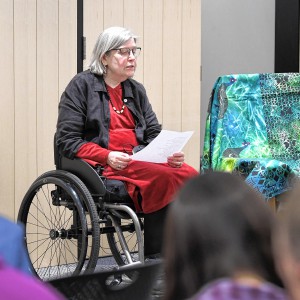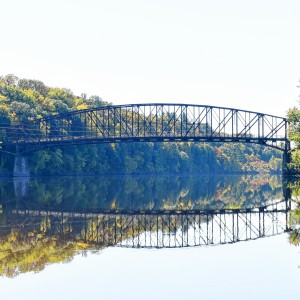Investing in the future at Big River Chestnuts Farm in Sunderland
| Published: 09-07-2021 4:42 PM |
SUNDERLAND — At first glance, it might seem like Jono Neiger’s 7-acre plot of land next to the Connecticut River is an unkempt, chaotic mess, with underbrush spilling from the rows of young chestnut trees.
However, there’s a method to the madness for the plants and dense bushes surrounding the trees at Neiger’s Big River Chestnuts Farm in Sunderland. These “wild areas” help stimulate the soil and wildlife in the area, thus creating a sustainable farming practice while he waits for the chestnuts to reach full production, which can take anywhere from 15 to 18 years.
“The idea is that while the trees are growing, the land is this amazing habitat,” Neiger said. “There’s a riot of flowers and growth, monarch butterflies flying around and tons of pollinators.”
Neiger has a background in field biology and has worked in food production for 30 years. He is a founding partner of Regenerative Design Group, a land-use planning and design group based in Greenfield.
He started the farm in 2018 with plans to jumpstart agroforestry, a form of sustainable farming, and to “stimulate a nut-growing industry” in the region.
“The goal,” Neiger said, “is having production and preservation values.”
Neiger is using a concept called agroforestry, which is a farming technique that “recharges” the environment as there is little human intervention beyond the initial planting and routine care and maintenance.
“We don’t have to till the ground every year, we don’t have to break the soil,” Neiger said. “The whole suite of agroforestry strategies is to shift away. … It’s a win-win-win of farm viability, food and ecosystem services.”
Article continues after...
Yesterday's Most Read Articles
Neiger’s farm uses a technique called alley cropping, which is the practice of planting two rows of trees with a small companion crop, such as berries, in between. Neiger currently has aronia — also known as chokeberries — elderberries and other various flowers and bushes growing on his farm as he waits for the chestnut trees to grow.
All of these crops come together to create a web of greenery that doesn’t look or operate like modern farms.
“The goal is not a clean agriculture. We can tolerate some wildness,” Neiger said. “We’re hoping to show there’s a different way to do things.”
Neiger noted erosion control, creation of a wild habitat and the sequestering of carbon are a few of the benefits of alley cropping and agroforestry. In its Agroforestry Strategic Framework document for 2019-2024, the U.S. Department of Agriculture calls agroforestry a “unique land management approach” that supports “healthy, sustainable agriculture systems, economies and communities.”
Alley cropping and harvesting of berries is only the first step at Neiger’s farm. The ultimate goal is to harvest from his 375 Japanese, Chinese and hybrid chestnut trees.
He said chestnuts are a “global staple crop” that America has forgotten about since the chestnut blight in the early 1900s. The chestnut blight was a fungus introduced to the U.S. from Japanese chestnut trees that wiped out an estimated 3.5 billion trees, according to Cornell University’s Plant Disease Diagnostic Clinic.
Neiger said it’s unfortunate the crop fell out of favor with the U.S. because chestnuts can be produced in enormous quantities without having to disrupt the land.
“It’s having this massive continent of land and the ability to grow these grain crops with huge tillage operations and sort of forgetting there’s this whole opportunity to do no till,” Neiger said.
The trees, which were planted when they were 12 months old, are into their fourth year in the field and some are beginning to sprout burrs, which are maturing chestnuts. Neiger said Big River Chestnuts Farm will begin selling its harvest in a few years as production begins to ramp up. Full production is up to 50 to 100 pounds of chestnuts per tree each year.
“By year six to eight we’ll have pretty good yields and quantities that we’ll be selling,” Neiger said. “Full production is really 15 to 18 years and they’ll produce for hundreds of years.”
Chestnut trees take up to 25 years to reach their full height. The farm’s final form will look more like a forest than an agricultural operation.
“It’ll be pretty much a forest,” Neiger said, “with a meadow and grazing.”
As the trees grow and their canopy blocks sunlight, some of the berry plants will be moved and other, more hardy plants will be planted in their place.
Most care for the trees comes early in their life. Neiger explained they need help “getting established early on” in the form of being watered in the case of a drought, and small fences around the trunks to protect from deer and voles.
“The first few years they definitely take some tending,” Neiger said. “There are people who just put them in the ground and mow them and irrigate them. … They’re a super hardy tree.”
Six to eight years of growth just for enough production to sell in bulk is a long-term commitment and Neiger said that is the most difficult part is getting other farmers to buy in. He added agroforestry practices is one way to use that time, but the thought of waiting half a decade to sell chestnuts scares people away.
“This is multigenerational,” Neiger said. “We Americans don’t think long-term. … It’s easy to go ahead and do annual vegetables that you can stop the next year. If you put in chestnuts, you commit for a long time.”
He said he gives tours of the farm to area farmers right now, but he is hopeful he will be more persuasive once chestnuts start dropping from the trees.
“When you have trees overhead, it’s a little easier to explain,” Neiger said. “It’s even easier to explain when I give them a bag of chestnuts they can eat.”
Neiger said chestnuts are not a common part of most Americans diets, but many immigrants and first-generation families drive the demand. He added chestnuts are a versatile crop and can be eaten or made into flour and oil.
“Americans hardly even eat chestnuts per capita compared to other people,” he said. “We’re the only country that doesn’t have a global industry. We can grow chestnuts and there’s a lot of opportunities.”
While the industry is in its early stages across the country, he said there is “tons of buzz” around the crop. He explained the chestnut industry could provide tons of food for communities while also benefiting both farmers and the environment.
“It’s bringing together ecology, food production and community,” Neiger said. “It’s exploding.”
Chris Larabee can be reached at clarabee@recorder.com or 413-930-4081.

 Joannah Whitney of Greenfield wins 33rd annual Poet’s Seat Poetry Contest
Joannah Whitney of Greenfield wins 33rd annual Poet’s Seat Poetry Contest William Strickland, a longtime civil rights activist, scholar and friend of Malcolm X, has died
William Strickland, a longtime civil rights activist, scholar and friend of Malcolm X, has died Photos: A musical classic returns
Photos: A musical classic returns Northfield appeals to Warren, Markey for Schell Bridge aid
Northfield appeals to Warren, Markey for Schell Bridge aid
